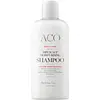What's inside
What's inside
 Key Ingredients
Key Ingredients

 Benefits
Benefits

 Concerns
Concerns

 Ingredients Side-by-side
Ingredients Side-by-side

Water
Skin ConditioningSodium Laureth Sulfate
CleansingGlycol Distearate
EmollientCoco-Betaine
CleansingGlycerin
HumectantDimethicone
EmollientCarbomer
Emulsion StabilisingCI 19140
Cosmetic ColorantCitric Acid
BufferingMenthol
Masking2-Oleamido-1,3-Octadecanediol
Skin ConditioningPPG-5-Ceteth-20
EmulsifyingSalicylic Acid
MaskingSelenium Sulfide
Sodium Benzoate
MaskingSodium Chloride
MaskingSodium Hydroxide
BufferingTocopheryl Acetate
AntioxidantParfum
MaskingWater
Skin ConditioningDisodium Laureth Sulfosuccinate
CleansingCocamidopropyl Betaine
CleansingSorbitol
HumectantSodium Laureth Sulfate
CleansingPEG-7 Glyceryl Cocoate
EmulsifyingLaureth-3
EmulsifyingSucrose Cocoate
EmulsifyingPEG-150 Distearate
EmulsifyingBeta-Glucan
Skin ConditioningPanthenol
Skin ConditioningMaltodextrin
AbsorbentGuar Hydroxypropyltrimonium Chloride
Skin ConditioningPropylene Glycol
HumectantDimethicone
EmollientDimethicone Propyl Pg-Betaine
CleansingSodium Chloride
MaskingLactic Acid
BufferingAscorbyl Palmitate
AntioxidantPhenoxyethanol
PreservativeSodium Benzoate
MaskingPotassium Sorbate
PreservativeWater, Disodium Laureth Sulfosuccinate, Cocamidopropyl Betaine, Sorbitol, Sodium Laureth Sulfate, PEG-7 Glyceryl Cocoate, Laureth-3, Sucrose Cocoate, PEG-150 Distearate, Beta-Glucan, Panthenol, Maltodextrin, Guar Hydroxypropyltrimonium Chloride, Propylene Glycol, Dimethicone, Dimethicone Propyl Pg-Betaine, Sodium Chloride, Lactic Acid, Ascorbyl Palmitate, Phenoxyethanol, Sodium Benzoate, Potassium Sorbate
 Reviews
Reviews

Ingredients Explained
These ingredients are found in both products.
Ingredients higher up in an ingredient list are typically present in a larger amount.
Dimethicone is a type of synthetic silicone created from natural materials such as quartz.
What it does:
Dimethicone comes in different viscosities:
Depending on the viscosity, dimethicone has different properties.
Ingredients lists don't always show which type is used, so we recommend reaching out to the brand if you have questions about the viscosity.
This ingredient is unlikely to cause irritation because it does not get absorbed into skin. However, people with silicone allergies should be careful about using this ingredient.
Note: Dimethicone may contribute to pilling. This is because it is not oil or water soluble, so pilling may occur when layered with products. When mixed with heavy oils in a formula, the outcome is also quite greasy.
Learn more about DimethiconeSodium Benzoate is a preservative. It's used in both cosmetic and food products to inhibit the growth of mold and bacteria. It is typically produced synthetically.
Both the US FDA and EU Health Committee have approved the use of sodium benzoate. In the US, levels of 0.1% (of the total product) are allowed.
Sodium benzoate works as a preservative by inhibiting the growth of bacteria inside of cells. It prevents the cell from fermenting a type of sugar using an enzyme called phosphofructokinase.
It is the salt of benzoic acid. Foods containing sodium benzoate include soda, salad dressings, condiments, fruit juices, wines, and snack foods.
Studies for using ascorbic acid and sodium benzoate in cosmetics are lacking, especially in skincare routines with multiple steps.
We always recommend speaking with a professional, such as a dermatologist, if you have any concerns.
Learn more about Sodium BenzoateChances are, you eat sodium chloride every day. Sodium Chloride is also known as table salt.
This ingredient has many purposes in skincare: thickener, emulsifier, and exfoliator.
You'll most likely find this ingredient in cleansers where it is used to create a gel-like texture. As an emulsifier, it also prevents ingredients from separating.
There is much debate on whether this ingredient is comedogenic. The short answer - comedogenic ratings don't tell the whole story. Learn more about comegodenic ratings here.
The concensus about this ingredient causing acne seems to be divided. Research is needed to understand if this ingredient does cause acne.
Scrubs may use salt as the primary exfoliating ingredient.
Learn more about Sodium ChlorideSodium Laureth Sulfate (SLES) is a foaming, cleansing, and emulsifying ingredient. It is created from palm kernel oil or coconut oil. SLES is not the same as sodium lauryl sulfate. It is much milder and less likely to irritate.
SLES helps create foam in personal products. It also prevents ingredients from separating, helping to elongate the shelf life.
Sodium Laureth Sulfate is a type of sulfate. It can be drying. We recommend speaking with a professional about using this ingredient if you have concerns.
Learn more about Sodium Laureth SulfateWater. It's the most common cosmetic ingredient of all. You'll usually see it at the top of ingredient lists, meaning that it makes up the largest part of the product.
So why is it so popular? Water most often acts as a solvent - this means that it helps dissolve other ingredients into the formulation.
You'll also recognize water as that liquid we all need to stay alive. If you see this, drink a glass of water. Stay hydrated!
Learn more about Water